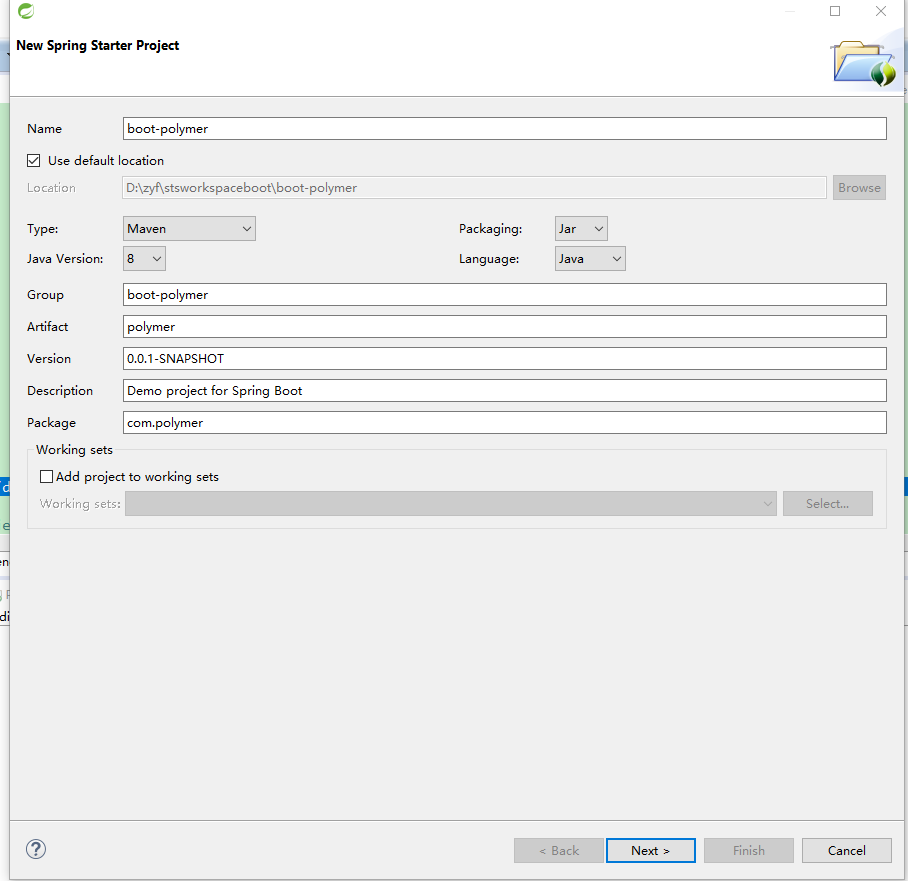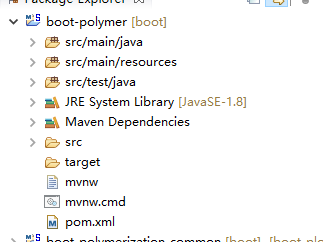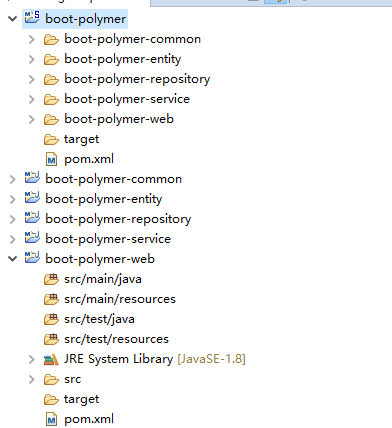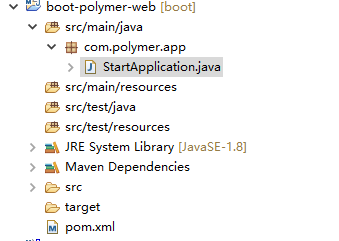比起传统复杂的单体工程,使用Maven的多模块配置,可以帮助项目划分模块,鼓励重用,防止POM变得过于庞大,方便某个模块的构建,而不用每次都构建整个项目,并且使得针对某个模块的特殊控制更为方便。接下来,本文将重点阐述SpringBoot在Maven环境的多模块构建过程。
第一步:创建父工程
使用spring Tool Suite的童鞋可以直接new一个spring starter project;使用idea和eclipse童鞋可以通过插件使用 Spring Initializr ,快速创建springboot工程;

 然后去掉,无关紧要的东西留下pom文件就好了,这样父工程就创建好了;
然后去掉,无关紧要的东西留下pom文件就好了,这样父工程就创建好了;
第二步:给父工程添加pom文件配置:
<?xml version="1.0" encoding="UTF-8"?>
<project xmlns="http://maven.apache.org/POM/4.0.0" xmlns:xsi="http://www.w3.org/2001/XMLSchema-instance"
xsi:schemaLocation="http://maven.apache.org/POM/4.0.0 http://maven.apache.org/xsd/maven-4.0.0.xsd">
<!-- 基本信息 -->
<description>SpringBoot 多模块构建示例</description>
<modelVersion>4.0.0</modelVersion>
<name>boot-polymer</name>
<packaging>pom</packaging>
<!-- 项目说明:这里作为聚合工程的父工程 -->
<groupId>com.polymer</groupId>
<artifactId>boot-polymer</artifactId>
<version>1.0.0.RELEASE</version>
<!-- 继承说明:这里继承SpringBoot提供的父工程 -->
<parent>
<groupId>org.springframework.boot</groupId>
<artifactId>spring-boot-starter-parent</artifactId>
<version>2.1.2.RELEASE</version>
<relativePath /> <!-- lookup parent from repository -->
</parent>
<!-- 模块说明:这里声明多个子模块 -->
<modules>
<module>boot-polymer-web</module>
<module>boot-polymer-service</module>
<module>boot-polymer-repository</module>
<module>boot-polymer-entity</module>
<module>boot-polymer-common</module>
</modules>
<properties>
<java.version>1.8</java.version>
</properties>
<dependencyManagement>
<dependencies>
<dependency>
<groupId>com.polymerization</groupId>
<artifactId>boot-polymer-web</artifactId>
<version>1.0.0.RELEASE</version>
</dependency>
<dependency>
<groupId>com.polymerization</groupId>
<artifactId>boot-polymer-service</artifactId>
<version>1.0.0.RELEASE</version>
</dependency>
<dependency>
<groupId>com.polymerization</groupId>
<artifactId>boot-polymer-repository</artifactId>
<version>1.0.0.RELEASE</version>
</dependency>
<dependency>
<groupId>com.polymerization</groupId>
<artifactId>boot-polymer-entity</artifactId>
<version>1.0.0.RELEASE</version>
</dependency>
<dependency>
<groupId>com.polymerization</groupId>
<artifactId>boot-polymer-common</artifactId>
<version>1.0.0.RELEASE</version>
</dependency>
</dependencies>
</dependencyManagement>
</project>
第三步;创建子工程
右击父工程->new ->maven module->创建选择jar->全部创建jar包工程,别创建war包否则你就别用springboot,不要问为什么

第四步:测试工程是否能启动
首先在boot-polymer-web工程添加pom配置
<project xmlns="http://maven.apache.org/POM/4.0.0" xmlns:xsi="http://www.w3.org/2001/XMLSchema-instance"
xsi:schemaLocation="http://maven.apache.org/POM/4.0.0 http://maven.apache.org/xsd/maven-4.0.0.xsd">
<modelVersion>4.0.0</modelVersion>
<parent>
<groupId>com.polymer</groupId>
<artifactId>boot-polymer</artifactId>
<version>1.0.0.RELEASE</version>
</parent>
<artifactId>boot-polymer-web</artifactId>
<dependencies>
<dependency>
<groupId>com.polymer</groupId>
<artifactId>boot-polymer-service</artifactId>
</dependency>
<dependency>
<groupId>com.polymer</groupId>
<artifactId>boot-polymer-repository</artifactId>
</dependency>
<dependency>
<groupId>com.polymer</groupId>
<artifactId>boot-polymer-entity</artifactId>
</dependency>
<dependency>
<groupId>com.polymer</groupId>
<artifactId>boot-polymer-common</artifactId>
</dependency>
<dependency>
<groupId>org.springframework.boot</groupId>
<artifactId>spring-boot-starter-web</artifactId>
</dependency>
<dependency>
<groupId>org.springframework.boot</groupId>
<artifactId>spring-boot-starter-test</artifactId>
<scope>test</scope>
</dependency>
</dependencies>
</project>
然后再web项目下新建一个启动类:

package com.polymer.app; import org.springframework.boot.SpringApplication; import org.springframework.boot.autoconfigure.SpringBootApplication; import org.springframework.web.bind.annotation.RequestMapping; import org.springframework.web.bind.annotation.RestController; import org.springframework.web.servlet.config.annotation.ResourceHandlerRegistry; @RestController @SpringBootApplication //Spring Boot核心注解,用于开启自动配置 public class StartApplication { //程序可以直接在此启动 @RequestMapping("/") String index(){ return "ok"; } public static void main(String[] args) { SpringApplication.run(StartApplication.class, args); } public void addResourceHandlers(ResourceHandlerRegistry registry) { //配置静态资源处理 registry.addResourceHandler("/**") .addResourceLocations("classpath:/META-INF/") .addResourceLocations("classpath:/hospitalpay"); } }
然后run as application——》

看到这个就表示启动成功了;然后再去访问一下

成功了;